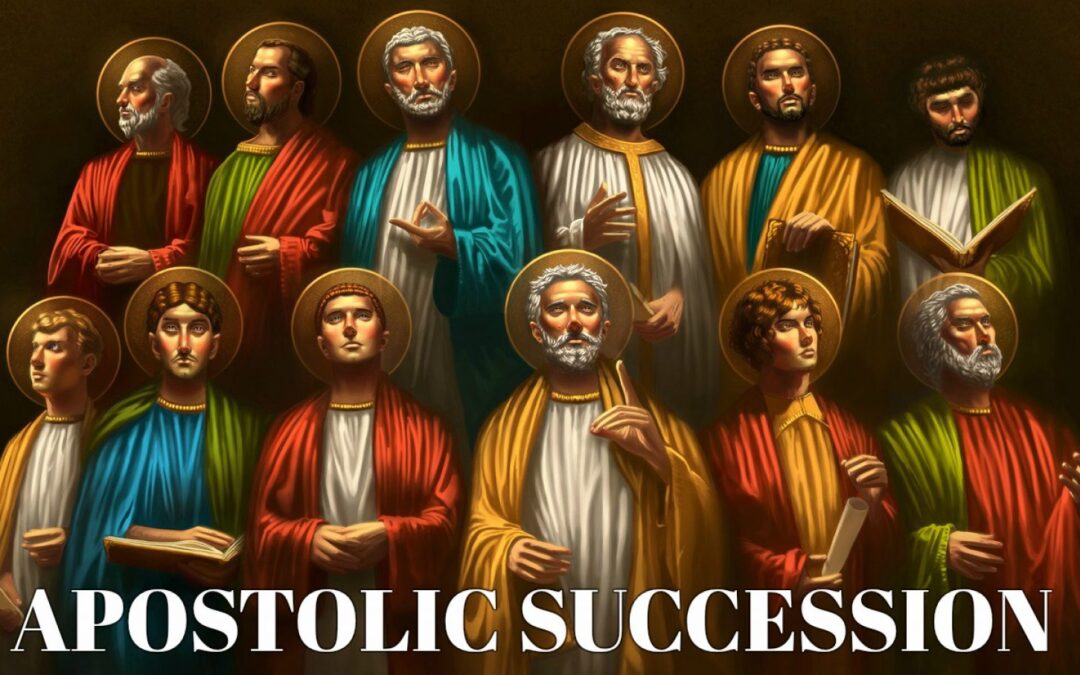When talking about historic theology, and the development of the Church throughout the ages, one of those topics that is bound to come up, particularly when talking to Roman Catholic or Orthodox brothers & sisters is the idea of Apostolic succession. According to classically define Apostolic succession, in order for a Church, holy orders, and thus sacraments to be valid, they must be administered by clergy, who were ordained by valid bishops, who have a direct line, similar to that of a family tree all the way back to the original 12 Apostles. For them, this means that there is an unbroken line of authority and teaching that has been passed down since the founding of the Church to today.
This is certainly fascinating history to dig into and examine; like this list from Orthodox Wiki that shows the entire line of everyone who has been the Patriarch of Antioch since St. Peter the Apostle would have instituted or planted that particular church. (https://orthodoxwiki.org/List_of_Patriarchs_of_Antioch) While Protestants at first glance might glance this idea off as insignificant or unimportant I think we need to take a moment of pause and to consider the importance of this. We have brothers and sisters in Christ who can trace their church leadership, by name and in great detail back to the 12 apostles. That is amazing in my mind, and a blessing that there has been such continuity in one of the original churches we have listed in the New Testament.
But this is where we hit a snag in the discussion. As a Protestant, according to the Catholic and Orthodox understanding of Apostolic Succession, I am not a part of a church with apostolic succession, and thus do not have valid ordination and valid sacraments. While I am considered a brother in Christ, I do not carry direct unbroken succession since the apostles, and thus am not apart of the One True Church that was founded by Jesus Himself.
This has looked differently throughout Church history since the reformation. Until the late 1800’s, Rome recognized Anglican ordination as valid, until a Papal Bull from Leo XIII axed their validity in Catholic canon law. But generally, anyone who is a theological descendant from the Reformation is not considered valid by the historic churches of Rome and the East.
The first question we might ask, “is this even important?” Certainly to those who descend from the radical reformation, with anabaptist tendencies the answer is likely no. Usually the argument goes that since the church fell away not long after the death of the apostles, the importance is that the true message of the Gospel is preached, and it is on that fact alone that makes a valid church. I think that this take, while containing truth goes too far. While ultimately the validity of the Church comes from it’s faithful transmission of the Gospel, we mustn’t be too quick to dismiss the importance of the institution in of itself.
It’s tempting, especially in our modern, democratic age, to think of the Church as purely a spiritual community, something fluid, dynamic, invisible, and inwardly held together by faith alone. But Scripture presents a far more balanced picture. The Church is both an organism and an institution, both mystical and visible. Paul calls the Church “the household of God” and “the pillar and foundation of the truth” (1 Tim. 3:15). The apostles did not just preach; they ordained elders, appointed deacons, and established tangible order in every city (Acts 14:23, Titus 1:5).
So when the ancient churches talk about apostolic succession, they are not wrong to emphasize continuity and order. God has always worked through tangible structures, through covenant, community, and leadership. The danger comes when we treat the structure as the substance, the line of succession as the guarantee of grace.
As Protestants, we often define the Church not primarily through institutional continuity but through fidelity to the apostolic Gospel—the faith once delivered to the saints (Jude 3). Yet, this doesn’t mean the visible and institutional Church is unimportant or something to shrug off. The Reformers didn’t reject the idea of structure—they rejected corruption and spiritual decay within it. They weren’t trying to destroy the Church’s continuity but to preserve its soul.
Richard Hooker, one of the great Anglican theologians, once argued that succession is only truly apostolic when it’s joined to apostolic doctrine. The laying on of hands, the continuity of ordination—these are good, meaningful signs, but they have to carry the content of the faith with them. John Wesley took a similar approach. Though he was never consecrated by a bishop in the ancient line, he understood himself and his Methodist preachers to be ministers in the apostolic spirit continuing the mission of the apostles to preach repentance and the forgiveness of sins. Though, interestingly enough there is an unverified legend that an Eastern Orthodox Bishop did consecrate Wesley as a bishop, thus potentially giving him valid Apostolic Succession. This is historically unverified, but does make an interesting thought experiment, that those in the Methodist tradition do have a potentially valid line of succession through Wesley himself to the Apostolic era. That being said, generally it is agreed that Wesley’s form of “succession” was not institutional, but spiritually rooted in faithfulness to the apostolic message rather than in the exact tracing of ordaining hands.
So when we talk about apostolic succession, we might say that yes, there’s a visible succession—an institutional passing down of ordination, authority, and office—and that’s important. It provides order, accountability, and continuity in teaching. But there’s also a spiritual succession—a faithful transmission of the Gospel through Word and Sacrament, empowered by the Spirit. Ideally, both should work together.
The institutional form protects the faith from fragmentation, while the spiritual vitality keeps the institution from turning into a museum piece. We need both: structure and Spirit, form and fire.
If there is hope for reconciliation or at least mutual understanding between Protestants, Catholics, and Orthodox believers, it lies in recognizing that both the institutional and the spiritual aspects of apostolic succession are necessary.
The historic churches remind us that the Gospel does not exist in a vacuum; it is always embodied, always transmitted through real people in real communities. Protestants remind the wider Church that structures exist to serve the Gospel, not the other way around. Both perspectives, when purified of pride, reveal vital truths.
There is room for dialogue and even shared recognition here. Protestants might affirm that the historic episcopate, rightly understood, is a gift for maintaining order and unity, a visible sign of the Church’s rootedness. Catholics and Orthodox might, in turn, acknowledge that the Spirit of Christ is not bound to lineage alone, but continues to call and empower ministers who faithfully preach the apostolic faith even outside canonical boundaries.
Perhaps the way forward is not to erase differences, but to listen deeply: to see in one another a shared desire to remain faithful to what has been handed down, and to steward it well for future generations.
A truly catholic (small “c”) vision of the Church would see apostolic succession as both faith and form, a faith faithfully handed down, through an order faithfully preserved. The lines of succession that Rome and the East maintain bear witness to the Church’s visible continuity, while the evangelical insistence on the primacy of the Gospel bears witness to her living continuity. Both, in their own way, protect what Christ entrusted to His Church.
So perhaps the middle way is to honor both truths: to recognize and celebrate the historic continuity of the ancient churches, while also affirming that the living power of the Gospel cannot be contained by institutional boundaries. The Spirit is not bound by human succession, and yet He works through the visible Church to maintain order, teach truth, and transmit grace.
We may not be able to trace our ordinations back to Peter or Paul, but we can trace our message, our Scriptures, and our sacraments to the same source, Jesus Christ, the cornerstone. The continuity of faith, hope, and love across the ages is the truest form of apostolic succession.
In the end, apostolic succession, whether understood institutionally or spiritually is meant to remind us of this: that the Church does not invent itself anew in every generation. We are stewards of something we did not create, heirs of a faith that has been handed down, and participants in a mission that began with twelve ordinary men and continues still through us today.

